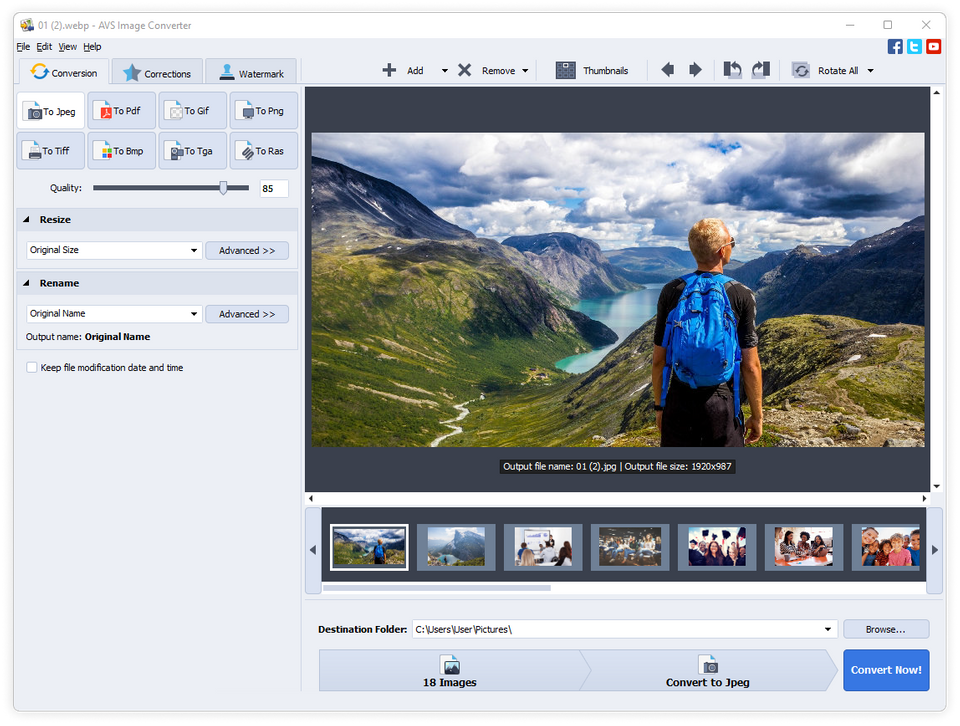Learn how to converting multi-frame tiff to gif in cross-platform .net environments. Explore tools, best practices, and workflows to streamline your image conversion process.
Introduction
In today’s digital landscape, working with various image formats is essential for developers, especially when dealing with high-quality images and animations. The Tagged Image File Format (TIFF) is widely regarded for its capability to store multi-frame images, making it the preferred format for archiving high-quality images in industries like photography, medical imaging, and publishing. However, when dealing with online applications or cross-platform systems, developers often face the challenge of converting multi-frame TIFF to GIF. This conversion becomes even more significant in .NET environments, where developers work across different platforms, such as Windows, Linux, and macOS. The process of converting multi-frame TIFF to GIF in cross-platform .NET environments offers multiple benefits, including easier integration of images into web applications, improved accessibility, and faster load times. In this blog post, we will explore the various methods and tools available for converting multi-frame TIFF to GIF in cross-platform .NET environments and examine how it can help streamline workflows, improve application performance, and enhance the user experience.
Understanding the Multi-Frame TIFF Format
The TIFF format is a versatile image format that supports multiple frames in a single file, which can be advantageous for various use cases such as document scanning, archiving, and storing high-resolution images. Multi-frame TIFF files are especially useful in scenarios where it is necessary to manage multiple images in one container, simplifying organization and retrieval. TIFF files can hold several images with different bit depths, color profiles, and compression methods, making them a preferred choice for industries where image quality is paramount. However, despite its advantages, the TIFF format can be cumbersome to work with in web and mobile applications, where file size and load speed are crucial considerations. This is where converting multi-frame TIFF to GIF becomes an essential process, particularly for cross-platform development in .NET environments. TIFF files are often large due to their high image quality and resolution, making them less suitable for web-based applications. By converting multi-frame TIFF files to GIF, developers can ensure that images are compressed without significant loss in quality, allowing for faster loading times and smoother animations across multiple platforms.
GIF Format: A Brief Overview
The Graphics Interchange Format (GIF) is a widely-used image format that is particularly well-known for its support of animations and transparency. Unlike TIFF, which supports a broad range of color depths and image qualities, GIF files are limited to a palette of 256 colors. While this limitation can result in a decrease in image quality, especially for high-resolution or color-rich images, it also allows GIF files to be much smaller in size. GIFs are commonly used for simple animations, such as web banners, icons, and memes, making them ideal for online and digital marketing applications. The smaller file size of GIFs makes them easier to load and share, which is crucial in modern web development, where fast loading times and reduced data usage are key to providing a seamless user experience. Furthermore, GIFs support looping animations, enabling the creation of simple yet engaging content that can be displayed across websites, social media platforms, and mobile apps. Converting multi-frame TIFF files to GIF in cross-platform .NET environments helps developers leverage the strengths of both formats—preserving animation and reducing file size while ensuring compatibility with different systems.
The Need for Converting Multi-Frame TIFF to GIF
Converting multi-frame TIFF to GIF in cross-platform .NET environments is a crucial task for developers working in industries that require both high-quality images and efficient web performance. Multi-frame TIFF files are often used in fields such as medical imaging and archival purposes, where the preservation of image quality is essential. However, when it comes to creating web-based applications or user interfaces, TIFF files may not be the most suitable option due to their large file sizes and lack of support for animations. GIF, on the other hand, is better suited for online applications due to its small file sizes and ability to store animations in a single file. For example, developers building websites, mobile apps, or social media content often need to convert multi-frame TIFF files to GIFs to ensure that images are easily accessible, quick to load, and can be displayed across different devices and browsers. Additionally, GIF files are more easily embedded in web pages and supported across various platforms, making them an attractive choice for developers looking to provide a consistent user experience across both desktop and mobile environments.
Tools for Converting Multi-Frame TIFF to GIF in .NET
When it comes to converting multi-frame tiff to gif in cross-platform .net environments environments, there are several tools and libraries that can simplify the process. One of the most popular libraries for image manipulation in .NET is ImageMagick, which offers a wide range of functionality for handling image formats, including TIFF and GIF. ImageMagick supports multi-frame TIFF files and allows for the easy conversion of these files to GIFs while preserving the quality of the images as much as possible. Another useful tool is SkiaSharp, a cross-platform .NET library that provides high-performance 2D graphics rendering and image manipulation capabilities. SkiaSharp can also be used to handle multi-frame TIFF files and convert them to GIF format, making it an excellent option for developers working in .NET Core or Xamarin environments. Additionally, the DotNetCore API can be employed to automate the conversion process in .NET applications, offering developers a way to seamlessly integrate the conversion functionality into their workflows. Using these tools, developers can efficiently convert multi-frame TIFF files to GIF format in cross-platform .NET environments, ensuring that their images are optimized for use in web and mobile applications.

Benefits of Cross-Platform Conversion
The primary benefit of converting multi-frame TIFF to GIF in cross-platform .NET environments is the ability to ensure that images can be easily accessed and displayed on various operating systems, including Windows, Linux, and macOS. By leveraging cross-platform tools like ImageMagick or SkiaSharp, developers can ensure that their applications work seamlessly on different platforms without the need for platform-specific code or libraries. This is especially important for developers who are building web applications or mobile apps that need to function consistently across a wide range of devices and operating systems. Furthermore, the smaller file size of GIFs makes them more suitable for use in applications where data usage and loading times are important considerations. GIFs are optimized for web use, and by converting multi-frame TIFF files to GIFs, developers can significantly reduce the load times of their applications, enhancing the user experience and ensuring that their applications perform efficiently, regardless of the device or platform.
Handling Image Quality During Conversion
One of the main concerns when converting multi-frame TIFF to GIF in cross-platform .NET environments is the potential loss of image quality. TIFF files are often used for high-resolution images, and converting them to GIF format, with its limited color palette, can result in a decrease in image clarity, especially in images with a wide range of colors or fine details. However, developers can mitigate this issue by adjusting the settings during the conversion process to ensure that the images retain as much of their original quality as possible. For example, developers can choose to reduce the color depth of the TIFF file to match the 256-color limit of GIF while maintaining the overall appearance of the image. Additionally, GIF files can be optimized for web use, which involves further compression of the image to reduce file size without sacrificing quality. By carefully managing the settings during the conversion process, developers can strike a balance between maintaining image quality and ensuring that the file size remains manageable for web and mobile applications.
Workflow for Converting Multi-Frame TIFF to GIF in .NET
The workflow for converting multi-frame TIFF to GIF in cross-platform .NET environments typically involves a series of steps that ensure the images are properly prepared and converted. First, the developer must load the multi-frame TIFF file using a library such as ImageMagick or SkiaSharp. Once the file is loaded, the developer can then extract each frame from the TIFF file and convert it into an individual GIF frame. During this process, the developer may need to adjust the color palette or optimize the images for web use by reducing the number of colors or applying compression. After the frames have been converted, the developer can compile them into a single GIF file, ensuring that the frames are properly sequenced and that the final file size is optimized for web use. Once the GIF has been created, it can be embedded into web pages or mobile apps, providing users with a seamless and engaging experience. By following this workflow, developers can efficiently convert multi-frame TIFF files to GIF format and ensure that the images are suitable for use across different platforms.
Optimizing GIF for Web Use
When converting multi-frame TIFF to GIF in cross-platform .NET environments, optimizing the resulting GIF file for web use is crucial. GIFs are often used in web applications because of their small file size and ability to display animations, but their large file sizes can still present challenges for web developers. To ensure that the GIF files are optimized for fast loading times and efficient use of bandwidth, developers can employ several techniques during the conversion process. One common approach is to reduce the color depth of the GIF to the minimum number of colors required to represent the image. By doing so, developers can significantly reduce the size of the GIF without sacrificing too much quality. Additionally, developers can use lossy compression methods to further shrink the file size, which is especially useful when dealing with large multi-frame TIFF files. Finally, tools like Gifsicle can be used to further optimize the GIF by removing unnecessary metadata, reducing file size without compromising the quality of the image. By employing these optimization techniques, developers can ensure that the GIFs they create are suitable for web use, ensuring fast loading times and a positive user experience.
Conclusion
converting multi-frame tiff to gif in cross-platform .net environments environments offers numerous benefits, from reducing file sizes to improving web performance and enhancing user experience. By utilizing powerful libraries like ImageMagick, SkiaSharp, and the DotNetCore API, developers can efficiently handle the conversion process and ensure that their applications function seamlessly across different platforms. While the conversion may result in a loss of image quality due to the limitations of the GIF format, developers can mitigate this by carefully managing the conversion settings and optimizing the GIF for web use. Overall, the ability to convert multi-frame TIFF files to GIFs enables developers to improve the performance of their applications, ensure compatibility across multiple platforms, and provide users with faster-loading images and smoother animations.
Read also: evecancel.site What You Need to Know





